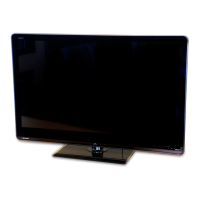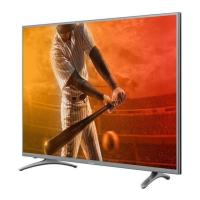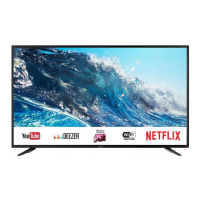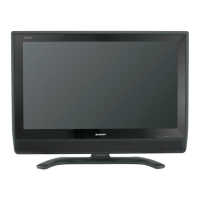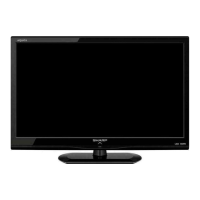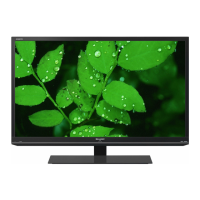Do you have a question about the Sharp AQUOS LC-46LE830M and is the answer not in the manual?
Observe the following items to ensure safe and proper operation.
Crucial guidelines for safe operation and product longevity.
Guidelines for cleaning and maintaining the TV's cabinet and front panel surfaces.
Safety advice regarding heat sources, ventilation, and transporting the television.
Additional items available for purchase to enhance TV functionality.
Instructions for assembling and attaching the TV stand to the unit.
Steps for connecting the antenna and external devices to the TV.
Guide to inserting batteries and operating the remote control.
Identification of buttons and indicators on the front of the television.
Diagram and labels for all terminals on the back of the TV.
Detailed breakdown and function of each button on the remote control.
Step-by-step guide to navigating the TV's menu and making basic adjustments.
Procedure for setting up the TV for the first time, including channel scanning.
How to turn the TV on/off, change channels, and select inputs.
Instructions for choosing different input signals for viewing.
How to change audio modes for NICAM and A2 broadcast signals.
Information on accessing and using the teletext service.
Configure the on-screen display language for the TV interface.
Manually select or automatically adjust the screen aspect ratio.
Use WSS for automatic picture size changes based on signal.
Manage input sources, including skipping and 4:3 aspect ratio settings.
Configure audio input for PC and HDMI2 terminals.
Assign custom names to input sources for easier identification.
Choose between TV speakers, headphones, or external audio systems.
Automatically adjust picture size when viewing HDMI signals.
Select the appropriate colour system for optimal image display.
Customize the visual effect displayed when changing channels.
Manually adjust the horizontal and vertical position of the displayed image.
Explore extra functions like LED illumination, game time, and button locking.
Connect and use USB devices or home network servers for media playback.
Choose between USB media or Home network, and select specific drives or servers.
Browse and view photos from USB media or home network in thumbnail or enlarged views.
Configure photo slide shows with background music and play music files.
Play video files from USB media or home network, including navigation and playback controls.
Adjust video aspect ratio and set up DivX® playback.
Check compatibility of USB devices and home network servers.
Connect the TV to your network using an Ethernet cable.
Connect the TV wirelessly using a LAN USB adapter.
Connect a PC to the TV and select appropriate picture sizes for display.
Details on compatible PC resolutions, frequencies, and signal types.
Automatically sync PC input for optimal display conditions.
Fine-tune PC image position, clock, and phase for clarity.
Control TV functions remotely using PC via IP or RS-232C connection, including commands.
Understand the different display formats for 3D and 2D images.
Enable automatic detection and display of 3D image signals.
Manually select between 3D and 2D viewing for unsupported signals.
Switch the TV display from 3D mode back to standard 2D mode.
Access the 3D menu to adjust settings like brightness and surround sound.
Adjust picture settings like AV mode and brightness boost for optimal 3D viewing.
Adjust the depth effect for still images displayed in 3D.
Test 3D functionality and manage 3D glasses settings for optimal performance.
Solutions for common issues encountered when viewing 3D images.
Common problems and their solutions for TV operation.
Steps to reset or clear the TV's password settings.
Restore TV settings to factory defaults if adjustments cannot be made.
Procedure to update the TV's software using a USB device.
Access TV identification details for customer service reporting.
Read software licences and view details on software composition and usage warnings.
Detailed technical specifications for all supported models.
Instructions for detaching the TV stand for wall mounting or storage.
Guidelines and precautions for securely mounting the TV to a wall.
Technical drawings showing the dimensions of various TV models.
Observe the following items to ensure safe and proper operation.
Crucial guidelines for safe operation and product longevity.
Guidelines for cleaning and maintaining the TV's cabinet and front panel surfaces.
Safety advice regarding heat sources, ventilation, and transporting the television.
Additional items available for purchase to enhance TV functionality.
Instructions for assembling and attaching the TV stand to the unit.
Steps for connecting the antenna and external devices to the TV.
Guide to inserting batteries and operating the remote control.
Identification of buttons and indicators on the front of the television.
Diagram and labels for all terminals on the back of the TV.
Detailed breakdown and function of each button on the remote control.
Step-by-step guide to navigating the TV's menu and making basic adjustments.
Procedure for setting up the TV for the first time, including channel scanning.
How to turn the TV on/off, change channels, and select inputs.
Instructions for choosing different input signals for viewing.
How to change audio modes for NICAM and A2 broadcast signals.
Information on accessing and using the teletext service.
Configure the on-screen display language for the TV interface.
Manually select or automatically adjust the screen aspect ratio.
Use WSS for automatic picture size changes based on signal.
Manage input sources, including skipping and 4:3 aspect ratio settings.
Configure audio input for PC and HDMI2 terminals.
Assign custom names to input sources for easier identification.
Choose between TV speakers, headphones, or external audio systems.
Automatically adjust picture size when viewing HDMI signals.
Select the appropriate colour system for optimal image display.
Customize the visual effect displayed when changing channels.
Manually adjust the horizontal and vertical position of the displayed image.
Explore extra functions like LED illumination, game time, and button locking.
Connect and use USB devices or home network servers for media playback.
Choose between USB media or Home network, and select specific drives or servers.
Browse and view photos from USB media or home network in thumbnail or enlarged views.
Configure photo slide shows with background music and play music files.
Play video files from USB media or home network, including navigation and playback controls.
Adjust video aspect ratio and set up DivX® playback.
Check compatibility of USB devices and home network servers.
Connect the TV to your network using an Ethernet cable.
Connect the TV wirelessly using a LAN USB adapter.
Connect a PC to the TV and select appropriate picture sizes for display.
Details on compatible PC resolutions, frequencies, and signal types.
Automatically sync PC input for optimal display conditions.
Fine-tune PC image position, clock, and phase for clarity.
Control TV functions remotely using PC via IP or RS-232C connection, including commands.
Understand the different display formats for 3D and 2D images.
Enable automatic detection and display of 3D image signals.
Manually select between 3D and 2D viewing for unsupported signals.
Switch the TV display from 3D mode back to standard 2D mode.
Access the 3D menu to adjust settings like brightness and surround sound.
Adjust picture settings like AV mode and brightness boost for optimal 3D viewing.
Adjust the depth effect for still images displayed in 3D.
Test 3D functionality and manage 3D glasses settings for optimal performance.
Solutions for common issues encountered when viewing 3D images.
Common problems and their solutions for TV operation.
Steps to reset or clear the TV's password settings.
Restore TV settings to factory defaults if adjustments cannot be made.
Procedure to update the TV's software using a USB device.
Access TV identification details for customer service reporting.
Read software licences and view details on software composition and usage warnings.
Detailed technical specifications for all supported models.
Instructions for detaching the TV stand for wall mounting or storage.
Guidelines and precautions for securely mounting the TV to a wall.
Technical drawings showing the dimensions of various TV models.

